| Tenrec Resources and Information |
What are tenrecs?
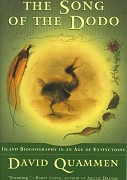
As an introduction to the fascinating mammal family called tenrecs, this website (www.tenrec.org) has kindly been granted permission by David Quammen to use a literary excerpt (chapter 8) from his highly recommended book The Song of the Dodo: Island Biogeography in an Age of Extinctions. The text remains © David Quammen.
Please note that a few taxonomic details have changed since the book's publication in 1996 - I have marked these and added brief footnotes at the bottom of this page.
The images (except for the book cover on the left) are not from the book, but copyrighted illustrations by Frithjof Spangenberg.
Another excellent illustrated introduction to tenrecs and their conservation can be found here - incidentally written by PJ Stephenson, the (human) protagonist of David Quammen's chapter reproduced below.
**************
THE TENRECS, for example, are closely allied species, coincident both in space and time.
The tenrecs are a family of extraordinary mammals - about thirty living species, spanning roughly the same size range as mice and rats but showing their own remarkable spectrum of physiological adaptations. Although a related subfamily of mammals (known as the otter shrews) occurs in western and central Africa, all other tenrecs are unique to the island of Madagascar. Wallace in his years of travel never reached Madagascar. Luckier, less intrepid, I do. At the Parc Botanique et Zoologique de Tsimbazaza, in a suburb of Antananarivo, I find a young Englishman who is happy to share his tenrecs.
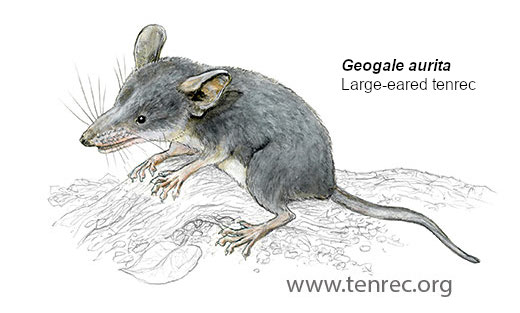
The Englishman's name is P. J. Stephenson. He is a doctoral student from the University of Aberdeen, transplanted to Madagascar for his research. He wears a white lab coat, which is no longer white, and a deceptively sleepy grin. He has just been building terraria so his hands are glopped with glue, P.J. explains. He rubs one hand through his hair. It's long, feral blond hair, suitable for a drummer in a band. P.J. blinks. Maybe he's dazed to be speaking English again suddenly; maybe I've interrupted a chain of tenrecoid thoughts. Maybe, glue or no, he was just catching a nap before I arrived. His lab area is a pair of stony gray chambers in a garage behind one of the Parc buildings, where not many visitors intrude. Tenrecs, he says, you're interested in tenrecs? Come.
I follow him to the back.
"Look here." P.J. lifts the lid off a terrarium. "This little guy is really freaky." We gaze down. The terrarium contains a substrate of wood shavings and some items of furniture. Otherwise it seems to be empty.
P.J. turns over a small piece of wood. No tenrec beneath that. He snatches up a cardboard tube and peeks down its bore, seeing only daylight. Then another tube, and another. Nothing. He checks the wood again, still nothing there, and the tubes again, his hand moving fast. "Hold on. He's hiding," says P.J. "Or else we've just had an escape. I hope not. Wait a minute, here he is." P.J. scoops up a handful of wood shavings. He cradles them toward his nose. He spreads his fingers. Wood shavings fall. "No. Wait. Here now." He scoops again. Finally, success and relief: In his palm is a tiny mammal.
Face like a carrot, dark little eyes, gray fur; it resembles a shrew. It isn't a shrew. It's a member of the species Geogale aurita, otherwise known as the large-eared tenrec. "He's a termite specialist," P.J. says fondly. "Hides in rotting wood. That's how I found him, actually - busting apart pieces of rotting wood."
P.J. intends to spend two years in Madagascar, busting apart more pieces of rotting wood, collecting more tenrecs, studying the peculiarities of their physiology. They embody some interesting questions. Why, for instance, do some tenrecs mature so quickly? One species reaches sexual maturity at the age of about forty days. Then again, certain other species mature rather slowly. And why do some of them produce such large litters? One species can carry as many as thirty-two fetuses, which is unusual among mammals. Then again, certain other species produce litters as small as one or two. Some of them have exceptionally low metabolic rates, and some don't. Some are capable of going into a state of torpor - turning their metabolism way down, saving energy - and some aren't. They're very diverse. What sort of mechanism controls the shift to torpor? And how can they have such a high reproductive rate, some of them, yet such a low metabolic rate? And what's the relationship between metabolic rate and body temperature? Between metabolic rate and diet? Why is this little termite eater so similar to a shrew in its anatomy and its ecology, yet so drastically different in how its body burns fuel? Why?
Having heard P.J. rattle off these questions, I'm ready to hear answers. I'll gladly surrender myself to the premise - for an hour or two, anyway - that tenrec physiology is the most intriguing of all branches of biological inquiry. What then, exactly, does it teach us? But P.J. doesn't have answers, not yet. What he has is a head full of curiosity, a lab full of animals, sticky hands, and two years to think. He sets the little termite eater back into its cage, where it instantly disappears.
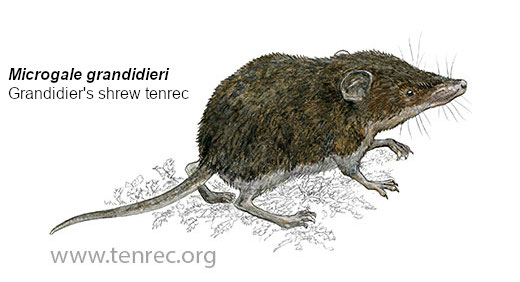
P.J. is maintaining quite a number of different species, but even his menagerie is just a modest sample of tenrec diversity. That diversity is part of what makes the group notable - they aren't only peculiar, they're peculiar in a profusion of different ways. Experts on tenrec taxonomy note that a single genus, Microgale, encompasses at least sixteen species: M. cowani, M. dobsoni, M. gracilis, M. principula, M. brevicaudata, and so on. The experts sort all these microgales into four categories, based on anatomical and ecological factors. There are burrowing, short-tailed microgales without much talent for leaping; there are surface-foraging microgales, also short-tailed, also nonleaping, that have some marginal talent for climbing; there are long-tailed surface-foragers that are good climbers; and there are very long tailed microgales that merit description as "climbers and ricochettors among branches," which sounds fantastic even for Madagascar. There's a Microgale longicaudata, whose name signals its membership among the very long tailed. None of this will be on the quiz at the end of the book.
The other genera include tenrecs that resemble moles, tenrecs that resemble hedgehogs (or, to an American eye, miniature porcupines), and an elusive aquatic tenrec named Limnogale mergulus1, which lives the life of a small river otter. P. J. Stephenson himself is one of very few scientists who have ever glimpsed Limnogale mergulus in the wild.
He and another bloke sat on a riverbank all of one night for that privilege, he tells me, being savaged by mosquitoes and holding their foolish damn flashlights.
P.J. shows me more tenrecs in more terraria. He shows me tenrecs in cardboard boxes, housed there temporarily while he cobbles together still more terraria. In another shed, he says, he's got larger tenrecs in wooden cages. And here's a tenrec in its own little submarine - that is, a sealed gas-monitor chamber suspended inside a tank of water - where P.J. can measure its oxygen use. Alongside the tank sit an electronic console and a needle-graph printer. Suddenly a thunderclap jars the sky above Antananarivo and the lights flicker in P.J.'s lab. The needle-graph printer emits a disconsolate click. It has turned itself off.
"Weather. Hold on." He resets the machine. "That could be a problem. We get a storm and everything's liable to shut down. Not good for the flow of data." The flow of data is lifeblood to a doctoral student. Breathing deeply, P.J. stirs a hand through his unruly yellow hair.
Tomorrow he will go off to collect more tenrecs from the wild. Having mentioned that, he remembers: "I've got to send a fellow out to get me some food." He moves for the door.
What kind of food, I wonder aloud, thinking I might cadge an invitation to join his field trip.
"Crickets," says P.J.
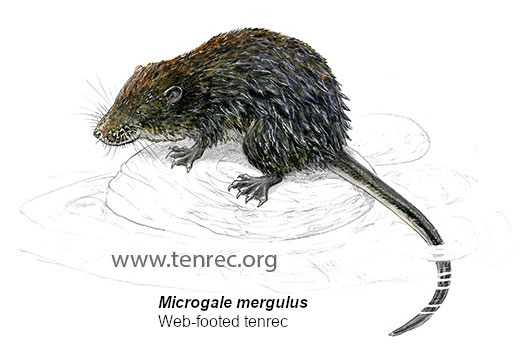
The tenrec family belongs to the order Insectivora - nominally the insect eaters, though not every species confines its diet to true insects such as crickets and termites. The streaked tenrec Hemicentetes nigriceps eats earthworms. The aquatic Limnogale mergulus1 eats frogs and crustaceans.
The Insectivora are sometimes considered to be among the most primitive mammals surviving today, and the tenrecs to be the most primitive of the Insectivora. Although "primitive" is an invidious word that raises objections from some biologists, the intended point is that tenrecs preserve certain traits that have been dispensed with by other mammal groups in the course of evolution. A tenrec commonly has bad eyesight. Its body temperature fluctuates. It possesses a cloaca, as birds do, instead of two separate openings for the reproductive and the digestive tracts, like other mammals. The male tenrec has no scrotum, instead retaining its testes inside its abdomen. The female gives birth to helpless young with their eyes and ears closed.
The slow development of those young, in some species, prolongs their dependence on the mother and their vulnerability to enemies. Bad eyesight, unsteady temperature, cloacal plumbing, internal testes, blind and deaf newborns - each of these represents a disadvantage in the struggle against competitor species and predators. The question arises, then, how the tenrecs have survived at all.
The answer is simple. They have survived by getting to Madagascar, where competition and predation are not nearly so intense as on the mainland.
Every species of tenrec (except for those anomalous African ottershrew forms) is endemic to Madagascar - meaning, native to this island and nowhere else. Their ancestors probably arrived sixty or seventy million years ago, near the end of the age of dinosaurs, at a time when mammalian evolution was still in its earliest stages. As the island became isolated from Africa (by geological splitting that widened and deepened what we now call the Mozambique Channel), only a few other mammal lineages got aboard: lemurs, rodents, viverrids, and the ancestors of that pygmy hippopotamus you've already heard about. An African aardvark2 reached Madagascar within the last few million years, somehow, but it didn't last. And an occasional small flock of wayward bats has come in on the winds. Compared with what exists on mainland Africa, Madagascar's list is dramatically short. The mammalian fauna is meager. Among the African mammal groups not present on the island (at least until humans began arriving by boat, bringing livestock and pets, causing extinctions, and otherwise muddling the biogeographical record) were these: the cat family, the dog family, elephants, zebras, rhinos, buffalo, antelopes, camels, and rabbits. Also, there was no Madagascan giraffe. There was no bear. There were no monkeys or apes, no otters or hyraxes, no porcupines. Within this gentle world of reduced competition and reduced predation, during the long eons of unbreached isolation, the tenrecs not only survived but prospered.
They multiplied. They spread all over the island. They took hold in the rainforests on the eastern slope of Madagascar, in the drier forests of the central plateau and the west, in the thorny desert of the south. They adapted to fill ecological niches that were otherwise empty. They diverged variously from their original type and were variously transmogrified into those thirty-some distinct species. They mitigated competition between one species and another by diverging still further. The scientific term for this process is adaptive radiation.
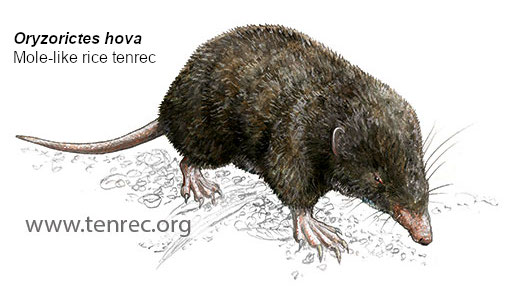
P.J. remembers a moment, earlier in his studies, when he picked up a volume of symposium papers and "there was this talk about adaptive radiation. I was reading it, and I just thought, 'Tenrecs. You're waiting to say tenrecs, that's what you're trying to say.' As an example. And it cited half a dozen things, but it didn't mention tenrecs. Whereas I think it's probably the most classic adaptive radiation I've ever seen in my life. Where you've got ancestral stock, it arrives on an island, finds all the niches available. Evolution takes its course. And it adapts to fill all the niches. I mean, you can't get something better." Blessed is the doctoral student who so loves his beasts. "You've got shrews, you've got hedgehogs, you've got moles. You've got things you can't possibly even describe. That have just evolved. It's absolutely unbelievable." Again he rubs at his hair, ever vigilant against the possibility that it has somehow gotten itself combed.
In the scientific literature, the tenrecs of Madagascar have been divided into two subfamilies, the Oryzorictinae and the Tenrecinae.3 Included among the Tenrecinae are all the larger, prickly-haired species that resemble hedgehogs. The Oryzorictinae include all the smaller species resembling moles and shrews. Somewhere between these two groups stands a missing link, a species called Cryptogale australis - in English, "the secretive southern tenrec." It has a skull like the Tenrecinae, body size and teeth like the Oryzorictinae. It's missing in the sense that it's apparently extinct, known only from remnant bones.4
Now let's recall again what Wallace wrote in Sarawak: Every species has come into existence coincident both in space and time with a pre-existing closely allied species. No matter that he had never reached Madagascar or studied tenrecs. He was finding the same pattern among the Borneo butterflies, among the cockatoos and the macaws, as well as in published reports of plant and animal distribution gathered from all over the world. The unstated point behind Wallace's "law" was that closely allied species come into existence not only near one another but from one another. The theory of special creation could not account for such patterns persuasively. A theory of evolution could.
Wallace's Sarawak paper was an overture. It hinted toward evolution but stopped short of explaining how the process might work. At that point in time, he had no theory to offer. Charles Darwin did have a theory but wasn't yet ready to offer it.
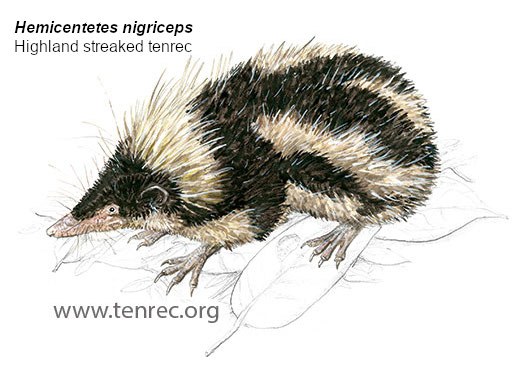
"Let me show you something," says P. J. Stephenson. "Here. This fellow's really freaky."
He lifts another lid to reveal a tenrec as hefty as a muskrat. It's a garish thing with black-and-white stripes like a skunk, sharp quills like a porcupine, a nose like an anteater. This is Hemicentetes nigriceps, P.J. says, the famous earthworm specialist. It lives at the edge of the central plateau and in the rainforest of the eastern slope, and it does pretty well around rice paddies also. The quills are barbed and detachable so that they can come away in the muzzle of an enemy. Under attack, it erects those quills and makes bucking motions that threaten the attacker with a muzzle-load of painful regret. The black-and-white stripes, as with a skunk, offer a conspicuous form of visual warning: Mess with me and you'll wish you hadn't. Predators may be scarce on Madagascar, but they aren't nonexistent. The viverrids in particular, those mongoosey carnivores, are capable of forcing a tenrec to defend itself. Another nice little adaptive feature of H. nigriceps is that some of the quills have become modified into an organ of stridulation. They can be scraped together, like a bow on the strings of a fiddle, to produce a ratchety squeak by which a female signals her young. Having advanced so far along its own odd evolutionary path, H. nigriceps strains the meaning of the word "primitive."
P.J. reaches down dotingly and gives the tenrec a gentle rub.
So I reach down too. P.J.'s appreciation is contagious. The quills are benign when laid flat to the body. I pay my respects to H. nigriceps with a cordial little nudge.
"They're rather nasty biters, actually," P.J. says.
**************
1 Now re-named Microgale mergulus based on genetic studies
2 This refers to the genus Plesiorycteropus, which more recently has been reassigned to have been a tenrecoid rather than an aardvark.
3 Geogale aurita is now placed in its own subfamily, the Geogalinae.
4 Cryptogale australis has been considered a synonym of Geogale aurita since Heim de Balsac (1972).